-
No Shelf Required

-
Salt Sugar Fat
Posted by Lois Seelandt on 4/1/2021 6:00:00 PM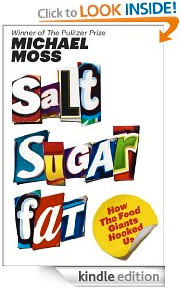 In the spring of 1999 the heads of the world’s largest processed food companies—from Coca-Cola to Nabisco—gathered at Pillsbury headquarters in Minneapolis for a secret meeting. On the agenda: the emerging epidemic of obesity, and what to do about it.
In the spring of 1999 the heads of the world’s largest processed food companies—from Coca-Cola to Nabisco—gathered at Pillsbury headquarters in Minneapolis for a secret meeting. On the agenda: the emerging epidemic of obesity, and what to do about it.
Increasingly, the salt-, sugar-, and fat-laden foods these companies produced were being linked to obesity, and a concerned Kraft executive took the stage to issue a warning: There would be a day of reckoning unless changes were made. This executive then launched into a damning PowerPoint presentation—114 slides in all—making the case that processed food companies could not afford to sit by, idle, as children grew sick and class-action lawyers lurked. To deny the problem, he said, is to court disaster.
When he was done, the most powerful person in the room—the CEO of General Mills—stood up to speak, clearly annoyed. And by the time he sat down, the meeting was over.
Since that day, with the industry in pursuit of its win-at-all-costs strategy, the situation has only grown more dire. Every year, the average American eats thirty-three pounds of cheese (triple what we ate in 1970) and seventy pounds of sugar (about twenty-two teaspoons a day). We ingest 8,500 milligrams of salt a day, double the recommended amount, and almost none of that comes from the shakers on our table. It comes from processed food. It’s no wonder, then, that one in three adults, and one in five kids, is clinically obese. It’s no wonder that twenty-six million Americans have diabetes, the processed food industry in the U.S. accounts for $1 trillion a year in sales, and the total economic cost of this health crisis is approaching $300 billion a year.
In Salt Sugar Fat, Pulitzer Prize–winning investigative reporter Michael Moss shows how we got here. Featuring examples from some of the most recognizable (and profitable) companies and brands of the last half century—including Kraft, Coca-Cola, Lunchables, Kellogg, Nestlé, Oreos, Cargill, Capri Sun, and many more—Moss’s explosive, empowering narrative is grounded in meticulous, often eye-opening research.
Moss takes us inside the labs where food scientists use cutting-edge technology to calculate the “bliss point” of sugary beverages or enhance the “mouthfeel” of fat by manipulating its chemical structure. He unearths marketing campaigns designed—in a technique adapted from tobacco companies—to redirect concerns about the health risks of their products: Dial back on one ingredient, pump up the other two, and tout the new line as “fat-free” or “low-salt.” He talks to concerned executives who confess that they could never produce truly healthy alternatives to their products even if serious regulation became a reality. Simply put: The industry itself would cease to exist without salt, sugar, and fat. Just as millions of “heavy users”—as the companies refer to their most ardent customers—are addicted to this seductive trio, so too are the companies that peddle them. You will never look at a nutrition label the same way again. -
Fast Food Nation
Posted by Lois Seelandt on 3/29/2021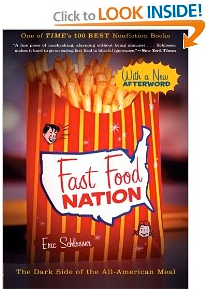 In 2001, Fast Food Nation was published to critical acclaim and became an international bestseller. Eric Schlosser’s exposé revealed how the fast food industry has altered the landscape of America, widened the gap between rich and poor, fueled an epidemic of obesity, and transformed food production throughout the world. The book changed the way millions of people think about what they eat and helped to launch today’s food movement.In a new afterword for this edition, Schlosser discusses the growing interest in local and organic food, the continued exploitation of poor workers by the food industry, and the need to ensure that every American has access to good, healthy, affordable food. Fast Food Nation is as relevant today as it was a decade ago. The book inspires readers to look beneath the surface of our food system, consider its impact on society and, most of all, think for themselves.
In 2001, Fast Food Nation was published to critical acclaim and became an international bestseller. Eric Schlosser’s exposé revealed how the fast food industry has altered the landscape of America, widened the gap between rich and poor, fueled an epidemic of obesity, and transformed food production throughout the world. The book changed the way millions of people think about what they eat and helped to launch today’s food movement.In a new afterword for this edition, Schlosser discusses the growing interest in local and organic food, the continued exploitation of poor workers by the food industry, and the need to ensure that every American has access to good, healthy, affordable food. Fast Food Nation is as relevant today as it was a decade ago. The book inspires readers to look beneath the surface of our food system, consider its impact on society and, most of all, think for themselves. -
Of Mice and Men
Posted by Lois Seelandt on 3/26/2021 12:00:00 PM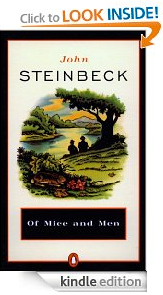 They are an unlikely pair: George is "small and quick and dark of face"; Lennie, a man of tremendous size, has the mind of a young child. Yet they have formed a "family," clinging together in the face of lonelinss and alienation.
They are an unlikely pair: George is "small and quick and dark of face"; Lennie, a man of tremendous size, has the mind of a young child. Yet they have formed a "family," clinging together in the face of lonelinss and alienation.Laborers in California's dusty vegetable fields, they hustle work when they can, living a hand-to-mouth existence. For George and Lennie have a plan: to own an acre of land and a shack they can call their own. When they land jobs on a ranch in the Salinas Valley, the fulfillment of their dream seems to be within their grasp. But even George cannot guard Lennie from the provocations of a flirtatious woman, nor predict the consequences of Lennie's unswerving obedience to the things George taught him.
-
River of Darkness
Posted by Lois Seelandt on 3/1/2021 2:00:00 PM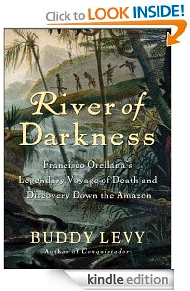 From the acclaimed author of Conquistador comes this thrilling account of one of history’s greatest adventures of discovery. With cinematic immediacy and meticulous attention to historical detail, here is the true story of a legendary sixteenth-century explorer and his death-defying navigation of the Amazon—river of darkness, pathway to gold.
From the acclaimed author of Conquistador comes this thrilling account of one of history’s greatest adventures of discovery. With cinematic immediacy and meticulous attention to historical detail, here is the true story of a legendary sixteenth-century explorer and his death-defying navigation of the Amazon—river of darkness, pathway to gold.
In 1541, the brutal conquistador Gonzalo Pizarro and his well-born lieutenant Francisco Orellana set off from Quito in search of La Canela, South America’s rumored Land of Cinnamon, and the fabled El Dorado, “the golden man.” Driving an enormous retinue of mercenaries, enslaved natives, horses, hunting dogs, and other animals across the Andes, they watched their proud expedition begin to disintegrate even before they descended into the nightmarish jungle, following the course of a powerful river. Soon hopelessly lost in the swampy labyrinth, their numbers diminishing daily through disease, starvation, and Indian attacks, Pizarro and Orellana made a fateful decision to separate. While Pizarro eventually returned home barefoot and in rags, Orellana and fifty-seven men, in a few fragile craft, continued downriver into the unknown reaches of the mighty Amazon, serenaded by native war drums and the eerie cries of exotic predators. Theirs would be the greater glory.
Interweaving eyewitness accounts of the quest with newly uncovered details, Buddy Levy reconstructs the seminal journey that has electrified adventurers ever since, as Orellana became the first European to navigate and explore the entire length of the world’s largest river. Levy gives a long-overdue account of the native populations—some peaceful and welcoming, offering sustenance and life-saving guidance, others ferociously hostile, subjecting the invaders to gauntlets of unremitting attack and intimations of terrifying rituals. And here is the Amazon itself, a powerful presence whose every twist and turn held the promise of new wonders both natural and man-made, as well as the ever-present risk of death—a river that would hold Orellana in its irresistible embrace to the end of his life.Overflowing with violence and beauty, nobility and tragedy, River of Darkness is both riveting history and a breathtaking adventure that will sweep readers along on an epic voyage unlike any other. -
What is Life?
Posted by Lois Seelandt on 2/26/2021 3:00:00 PM Nobel laureate Erwin Schrödinger's What is Life? is one of the great science classics of the twentieth century. A distinguished physicist's exploration of the question which lies at the heart of biology, it was written for the layman, but proved one of the spurs to the birth of molecular biology and the subsequent discovery of the structure of DNA. The philosopher Karl Popper hailed it as a 'beautiful and important book' by 'a great man to whom I owe a personal debt for many exciting discussions'. It appears here together with Mind and Matter, his essay investigating a relationship which has eluded and puzzled philosophers since the earliest times. Schrodinger asks what place consciousness occupies in the evolution of life, and what part the state of development of the human mind plays in moral questions. Brought together with these two classics are Schrödinger's autobiographical sketches, published and translated here for the first time. They offer a fascinating fragmentary account of his life as a background to his scientific writings, making this volume a valuable additon to the shelves of scientist and layman alike.
Nobel laureate Erwin Schrödinger's What is Life? is one of the great science classics of the twentieth century. A distinguished physicist's exploration of the question which lies at the heart of biology, it was written for the layman, but proved one of the spurs to the birth of molecular biology and the subsequent discovery of the structure of DNA. The philosopher Karl Popper hailed it as a 'beautiful and important book' by 'a great man to whom I owe a personal debt for many exciting discussions'. It appears here together with Mind and Matter, his essay investigating a relationship which has eluded and puzzled philosophers since the earliest times. Schrodinger asks what place consciousness occupies in the evolution of life, and what part the state of development of the human mind plays in moral questions. Brought together with these two classics are Schrödinger's autobiographical sketches, published and translated here for the first time. They offer a fascinating fragmentary account of his life as a background to his scientific writings, making this volume a valuable additon to the shelves of scientist and layman alike. -
Sync
Posted by Lois Seelandt on 2/1/2021 1:00:00 PM The tendency to synchronize may be the most mysterious and pervasive drive in all of nature. It has intrigued some of the most brilliant minds of the 20th century, including Albert Einstein, Richard Feynman, Norbert Wiener, Brian Josephson, and Arthur Winfree.
The tendency to synchronize may be the most mysterious and pervasive drive in all of nature. It has intrigued some of the most brilliant minds of the 20th century, including Albert Einstein, Richard Feynman, Norbert Wiener, Brian Josephson, and Arthur Winfree.At once elegant and riveting, Sync tells the story of the dawn of a new science. Steven Strogatz, a leading mathematician in the fields of chaos and complexity theory, explains how enormous systems can synchronize themselves, from the electrons in a superconductor to the pacemaker cells in our hearts. He shows that although these phenomena might seem unrelated on the surface, at a deeper level there is a connection, forged by the unifying power of mathematics.
-
Fahrenheit 451
Posted by Lois Seelandt on 1/8/2021 1:00:00 PM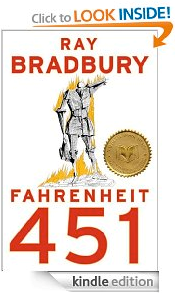
Guy Montag is a fireman. In his world, where television rules and literature is on the brink of extinction, firemen start fires rather than put them out. His job is to destroy the most illegal of commodities, the printed book, along with the houses in which they are hidden.
Montag never questions the destruction and ruin his actions produce, returning each day to his bland life and wife, Mildred, who spends all day with her television “family.” But then he meets an eccentric young neighbor, Clarisse, who introduces him to a past where people didn’t live in fear and to a present where one sees the world through the ideas in books instead of the mindless chatter of television.
When Mildred attempts suicide and Clarisse suddenly disappears, Montag begins to question everything he has ever known. He starts hiding books in his home, and when his pilfering is discovered, the fireman has to run for his life.
-
Conquistador
Posted by Lois Seelandt on 1/4/2021 8:00:00 AM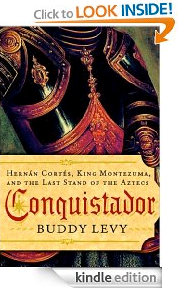 In an astonishing work of scholarship that reads like an adventure thriller, historian Buddy Levy records the last days of the Aztec empire and the two men at the center of an epic clash of cultures.
In an astonishing work of scholarship that reads like an adventure thriller, historian Buddy Levy records the last days of the Aztec empire and the two men at the center of an epic clash of cultures.
“I and my companions suffer from a disease of the heart which can be cured only with gold.” —Hernán Cortés
It was a moment unique in human history, the face-to-face meeting between two men from civilizations a world apart. Only one would survive the encounter. In 1519, Hernán Cortés arrived on the shores of Mexico with a roughshod crew of adventurers and the intent to expand the Spanish empire. Along the way, this brash and roguish conquistador schemed to convert the native inhabitants to Catholicism and carry off a fortune in gold. That he saw nothing paradoxical in his intentions is one of the most remarkable—and tragic—aspects of this unforgettable story of conquest.In Tenochtitlán, the famed City of Dreams, Cortés met his Aztec counterpart, Montezuma: king, divinity, ruler of fifteen million people, and commander of the most powerful military machine in the Americas. Yet in less than two years, Cortés defeated the entire Aztec nation in one of the most astonishing military campaigns ever waged. Sometimes outnumbered in battle thousands-to-one, Cortés repeatedly beat seemingly impossible odds. Buddy Levy meticulously researches the mix of cunning, courage, brutality, superstition, and finally disease that enabled Cortés and his men to survive. -
The Great Gatsby
Posted by Lois Seelandt on 12/21/2020 8:00:00 AM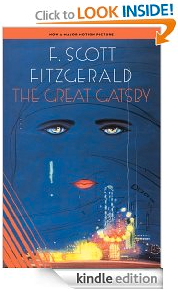 The exemplary novel of the Jazz Age, F. Scott Fitzgeralds' third book, The Great Gatsby (1925), stands as the supreme achievement of his career. T. S. Eliot read it three times and saw it as the "first step" American fiction had taken since Henry James; H. L. Mencken praised "the charm and beauty of the writing," as well as Fitzgerald's sharp social sense; and Thomas Wolfe hailed it as Fitzgerald's "best work" thus far. The story of the fabulously wealthy Jay Gatsby and his love for the beautiful Daisy Buchanan, of lavish parties on Long Island at a time when, The New York Times remarked, "gin was the national drink and sex the national obsession," it is an exquisitely crafted tale of America in the 1920s that resonates with the power of myth. A novel of lyrical beauty yet brutal realism, of magic, romance, and mysticism, The Great Gatsby is one of the great classics of twentieth-century literature.
The exemplary novel of the Jazz Age, F. Scott Fitzgeralds' third book, The Great Gatsby (1925), stands as the supreme achievement of his career. T. S. Eliot read it three times and saw it as the "first step" American fiction had taken since Henry James; H. L. Mencken praised "the charm and beauty of the writing," as well as Fitzgerald's sharp social sense; and Thomas Wolfe hailed it as Fitzgerald's "best work" thus far. The story of the fabulously wealthy Jay Gatsby and his love for the beautiful Daisy Buchanan, of lavish parties on Long Island at a time when, The New York Times remarked, "gin was the national drink and sex the national obsession," it is an exquisitely crafted tale of America in the 1920s that resonates with the power of myth. A novel of lyrical beauty yet brutal realism, of magic, romance, and mysticism, The Great Gatsby is one of the great classics of twentieth-century literature. -
The Particles of the Universe
Posted by Lois Seelandt on 12/3/2020 1:00:00 PM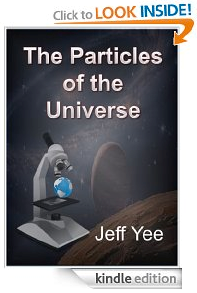 The universe is simply energy. Everything around us, including matter, is energy. A deep look into the mysteries of the subatomic world – the particles that make up the atom – provides answers to basic questions about how the universe works. To solve the future of mankind’s energy needs we need to understand the basic building blocks of the universe, including the atom and its parts. By exploring the subatomic world we’ll find more answers to our questions about time, forces like gravity and the matter that surrounds us. More importantly, we’ll find new ways to tap into the energy that exists around us to power our growing needs. In a new branch of particle physics, where tiny particles are thought of as energy waves, we find new answers that may help us in our quest to find alternative energy sources.
The universe is simply energy. Everything around us, including matter, is energy. A deep look into the mysteries of the subatomic world – the particles that make up the atom – provides answers to basic questions about how the universe works. To solve the future of mankind’s energy needs we need to understand the basic building blocks of the universe, including the atom and its parts. By exploring the subatomic world we’ll find more answers to our questions about time, forces like gravity and the matter that surrounds us. More importantly, we’ll find new ways to tap into the energy that exists around us to power our growing needs. In a new branch of particle physics, where tiny particles are thought of as energy waves, we find new answers that may help us in our quest to find alternative energy sources.

